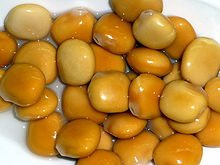Lupinus albus: Difference between revisions
→Cultivation and uses: In Spain, they are referred to with the diminutive "-ito". |
|||
| Line 39: | Line 39: | ||
In [[Greece]], and especially on the island of [[Crete]] and in the [[Peloponnese]] area, they are a very common snack during the period of lent before Easter. They are normally soaked in sea water for 2–3 hours to mellow the flavour and consumed raw. |
In [[Greece]], and especially on the island of [[Crete]] and in the [[Peloponnese]] area, they are a very common snack during the period of lent before Easter. They are normally soaked in sea water for 2–3 hours to mellow the flavour and consumed raw. |
||
In [[Italy]], [[Spain]] and [[Portugal]] it is a very popular snack (''lupini'' in Italian, ''tremoços'' in Portuguese, ''altramuces'' or '' |
In [[Italy]], [[Spain]] and [[Portugal]] it is a very popular snack (''lupini'' in Italian, ''tremoços'' in Portuguese, ''altramuces'' or ''chochos'' in Spanish) as well as in some regions of [[Brazil]]. |
||
=== History === |
=== History === |
||
Revision as of 15:30, 18 June 2013
| Lupinus albus | |
|---|---|

| |
| Scientific classification | |
| Kingdom: | |
| (unranked): | |
| (unranked): | |
| (unranked): | |
| Order: | |
| Family: | |
| Genus: | |
| Species: | L. albus
|
| Binomial name | |
| Lupinus albus | |
Lupinus albus, commonly known as the white lupin, is a member of the genus Lupinus in the family Fabaceae. It is a traditional pulse cultivated in the Mediterranean region.
Description
The white lupin is annual, more or less pubescent plant, 30 to 120 cm high, has a wide distribution in the Mediterranean region. White Lupine is widely spread as wild plants throughout the southern Balkans, the islands of Sicily, Corsica and Sardinia, and the Aegean Sea, as well as in Palestine and western Turkey. Occurs in meadows, pastures, and grassy slopes, predominantly on sandy and acid soils. It is cultivated over all the Mediterranean region and also in Egypt, Sudan, Ethiopia, Syria, Central and Western Europe, USA and South America, Tropical and Southern Africa, Russia, and Ukraine. The ancient culture of white lupin under the local name "hanchcoly" was practiced until recently in Western Georgia.
White lupin is distinct within the vast and polymorphous genus Lupinus L. for small variation of morphological characters. However, it has wide intraspecific variability in physiological plant properties: duration of vernalization time and growth rate, photoperiodic sensitivity, shape tolerance, drought resistance, cold- and winter-hardiness. There are winter and spring forms of white lupin. Duration of growing period under spring sowing varies from 106 to 180 days, seed mass per plant changes from 2.2 to 40 g, green mass yield per from 9 to 250 g, protein content in seed from 35.0 to 53.7%, and oil content from 6.2 to 12.0%.
The scheme of classification of Lupinus albus L.

- Subsp. graecus (Boiss. et Spun.) Franko et Silva
- Subsp. termis (Forsk.) Ponert.
- Var. abissinicus Libk.
- Var. subroseus Libk.
- Subsp. albus L.
- Var. albus
- Var.vavilovii (Atab.) Kurl. et Stankev.
- Var vulgaris Libk.
- f. libkindae Kurl. et Stankev.[1]
Cultivation and uses

According to Zohary and Hopf (123, 2000), “even today the white lupin is an appreciated food crop and it is still cultivated in some Mediterranean countries – particularly Egypt.” They list a number of archeological findsites that include Bronze age Thera and a number of Roman Egypt sites.
In Greece, and especially on the island of Crete and in the Peloponnese area, they are a very common snack during the period of lent before Easter. They are normally soaked in sea water for 2–3 hours to mellow the flavour and consumed raw.
In Italy, Spain and Portugal it is a very popular snack (lupini in Italian, tremoços in Portuguese, altramuces or chochos in Spanish) as well as in some regions of Brazil.
History
The beginning of the history of lupin cultivation in the Old World is often associated with the times of the ancient Egyptian civilization (Zhukovsky, 1929). It is, however, more likely (Kurlovich, 2002) that originally white lupin was introduced into cultivation in ancient Greece where its greatest biodiversity was concentrated and wild-growing forms have been preserved until nowadays (ssp. graecus). On the Balkan Peninsula representatives of another subspecies of white lupin (ssp. termis and ssp. albus) turned wild and grows now in natural environments. Besides, the Grecian genesis of cultivated lupin is testified by lupin’s Greek name termis, that may be translated as “ardent”. Until now, in many countries of the world water-soaked and boiled lupin seeds are sold on markets and in bars as delicacies (like sunflower seeds). White lupin dispersed step-by-step from Greece to adjacent countries, in particular, to Egypt and Ancient Rome. The forms with white seeds and pink-and-blue or light-pink flowers (L. termis) spread mainly towards the south (Egypt, Libya and Palestine), while the forms with white seeds and grayish-blue or white flowers (L. albus) moved to the west (Apennine Peninsula and farther).[2]
References
- Kurlovich B.S. (2002) Lupins. Geography, classification, genetic resources and breeding , St. Petersburg, “Intan”, 468p.
- Gladstones, J.S. 1974. Lupinus of the Mediterranean region and Africa. Bull. West. Austr. Depart. of Agr. 1974. N 26. 48 p.
- Gladstones, J.S. 1998. Distribution, Origin, Taxonomy, History and Importance. In: J.S. Gladstones et al. (eds.), Lupin as Crop Plants. Biology, Production and Utilization, 1-39.
- Zhukovsky, P.M. 1929. A contribution to the knowledge of genus Lupinus Tourn. Bull. Apll. Bot. Gen. Pl.-Breed., Leningrad-Moscow, XXI, I:16-294.
- Zohary, D. and Hopf, M. (2000) Domestication of plants in the Old World, third edition. Oxford: University Press.
- ^ BK (2006-08-04). "lupindiversity.blogspot.com/2006/08/lupinus-albus-l-white-lupin.html". Lupindiversity.blogspot.com. Retrieved 2012-08-04.
- ^ BK (2006-07-17). "lupins-bk.blogspot.com/2006/07/history-of-lupin-domestication.html". Lupins-bk.blogspot.com. Retrieved 2012-08-04.
